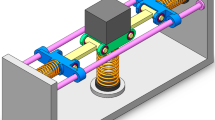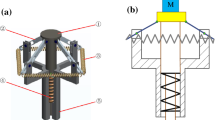Abstract
Quasi-zero-stiffness (QZS) vibration isolation can increase the isolation frequency and improve the isolation performance by using a negative stiffness mechanism. However, most of the QZS isolation are sensitive to the loads applied for achieving effective isolation. This paper focuses on the dynamic phenomenon of the pneumatic QZS isolator with mistuned mass. A pneumatic QZS vibration isolator is proposed. The dynamic equation of the QZS vibration isolator under mass mistuning is derived. Amplitude–frequency relationship and force transmissibility are analyzed and simulated. It is observed that the system exhibits the possible response period and chaos phenomenon in the case of a large mass mistuning. It is very interesting that mass detuning will lead to a more complex nonlinear response of the QZS isolator, and the dynamic response will also be more sensitive to changes in parameters, such as external excitation frequency and amplitude, and damping ratio. The presented works will be helpful to improve the structure of the pneumatic QZS vibration isolator and determine the applicable working frequency of the isolator.














Similar content being viewed by others
References
Carrella, A., Brennan, M.J., Waters, T.P.: Static analysis of a passive vibration isolator with quasi-zero-stiffness characteristic. J. Sound Vib. 301, 678–689 (2007)
Carrella, A., Brennan, M.J., Kovacic, I., Waters, T.P.: On the force transmissibility of a vibration isolator with quasi-zero-stiffness. J. Sound Vib. 322, 707–717 (2009)
Kovacic, I., Brennan, M.J., Waters, T.P.: A study of a nonlinear vibration isolator with a quasi-zero stiffness characteristic. J. Sound Vib. 315, 700–711 (2008)
Hao, Z., Cao, Q.: The isolation characteristics of an archetypal dynamical model with stable-quasi-zero-stiffness. J. Sound Vib. 340, 61–79 (2015)
Liu, C., Yu, K.: A high-static-low-dynamic-stiffness vibration isolator with the auxiliary system. Nonlinear Dyn. 94, 1549–1567 (2018)
Liu, C., Yu, K., Tang, J.: New insights into the damping characteristics of a typical quasi-zero-stiffness vibration isolator. Int. J. Non-Linear Mech. 124, 103511 (2020)
Zhou, J., Wang, X., Xu, D., Bishop, S.: Nonlinear dynamic characteristics of a quasi-zero stiffness vibration isolator with cam-roller-spring mechanisms. J. Sound Vib. 346, 53–69 (2015)
Ishida, S., Uchida, H.: Design and numerical analysis of vibration isolators with quasi-zero-stiffness characteristics using bistable foldable structures. J. Vib. Acoust. 139, 0310151 (2017)
Shan, Y., Wu, W., Chen, X.: Design of a miniaturized pneumatic vibration isolator with high-static-low-dynamic stiffness. J. Vib. Acoust. 137 (2015)
Liu, X.T., Huang, X.C., Hua, H.X.: On the characteristics of a quasi-zero stiffness isolator using Euler buckled beam as negative stiffness corrector. J. Sound Vib. 332, 3359–3376 (2013)
Huang, X.C., Liu, X.T., Sun, J.Y., Zhang, Z.Y., Hua, H.X.: Vibration isolation characteristics of a nonlinear isolator using Euler buckled beam as negative stiffness corrector: a theoretical and experimental study. J. Sound Vib. 333, 1132–1148 (2014)
Huang, X.C., Liu, X.T., Sun, J.Y., Zhang, Z.Y., Hua, H.X.: Effect of the system imperfections on the dynamic response of a high-static-low-dynamic stiffness vibration isolator. Nonlinear Dyn. 76, 1157–1167 (2014)
Fulcher, B.A., Shahan, D.W., Haberman, M.R., Seepersad, C.C., Wilson, P.S.: Analytical and experimental investigation of buckled beams as negative stiffness elements for passive vibration and shock isolation systems. J. Vib. Acoust. 136, 031009 (2014)
Huang, X.C., Liu, X.T., Hua, H.X.: On the characteristics of an ultra-low frequency nonlinear isolator using sliding beam as negative stiffness. J. Mech. Sci. Technol. 28, 813–822 (2014)
Ding, H., Chen, L.Q.: Nonlinear vibration of a slightly curved beam with quasi-zero-stiffness isolators. Nonlinear Dyn. 95, 2367–2382 (2019)
Robertson, W.S., Kidner, M.R.F., Cazzolato, B.S., Zander, A.C.: Theoretical design parameters for a quasi-zero stiffness magnetic spring for vibration isolation. J. Sound Vib. 326, 88–103 (2009)
Li, Q., Zhu, Y., Xu, D.F., Hu, J.C., Min, W., Pang, L.C.: A negative stiffness vibration isolator using magnetic spring combined with rubber membrane. J. Mech. Sci. Technol. 27, 813–824 (2013)
Zheng, Y.S., Zhang, X.N., Luo, Y.J., Zhang, Y.H., Xie, S.L.: Analytical study of a quasi-zero stiffness coupling using a torsion magnetic spring with negative stiffness. Mech. Syst. Signal Process. 100, 135–151 (2018)
Li, H., Zhang, J.: Design and analysis of a magnetic QZS vibration isolator. Appl. Mech. Mater. 470, 484–488 (2013)
Dong, G.X., Zhang, X.N., Xie, S.L., Yan, B., Luo, Y.J.: Simulated and experimental studies on a high-static–lowdynamic stiffness isolator using magnetic negative stiffness spring. Mech. Syst. Signal Process. 86, 188–203 (2017)
Shin, K.: On the performance of a single degree-of-freedom high-static–low-dynamic stiffness magnetic vibration isolator. Int. J. Precis. Eng. Manuf. 15, 439–445 (2014)
Zhou, J.X., Xiao, Q.Y., Xu, D.L., Ouyang, H.J., Li, Y.L.: A novel quasi-zero-stiffness strut and its applications in six degree-of-freedom vibration isolation platform. J. Sound Vib. 394, 59–74 (2017)
Hu, F.Z., Jing, X.J.: A 6-DOF passive vibration isolator based on Stewart structure with X-shaped legs. Nonlinear Dyn. 91, 157–185 (2018)
Zheng, Y.S., Li, Q.P., Yan, B., Luo, Y.J., Zhang, X.N.: A Stewart isolator with high-static–low-dynamic stiffness struts based on negative stiffness magnetic springs. J. Sound Vib. 422, 390–408 (2018)
Ye, K., Ji, J.C., Brown, T.: Design of a quasi-zero stiffness isolation system for supporting different loads. J. Sound Vib. 471, 115198 (2020)
Acknowledgements
This work is supported by National Natural Science Foundation of China (Grant No. 12072153), the Priority Academic Program Development of Jiangsu Higher Education Institutions and the Research Fund of State Key Laboratory of Mechanics and Control of Mechanical Structures (Nanjing University of Aeronautics and astronautics) (Grant No. MCMS-I-0121G01), which are greatly appreciated.
Author information
Authors and Affiliations
Corresponding author
Ethics declarations
Conflict of interest
The authors declare that they have no known competing financial interests or personal relationships that could have appeared to influence the work reported in this paper.
Data availability
All data generated or analyzed during this study are included in this published article.
Additional information
Publisher's Note
Springer Nature remains neutral with regard to jurisdictional claims in published maps and institutional affiliations.
Appendix
Appendix
If the second-order unstable region of the system is to be discussed, the solution form of Eq. (19) can be assumed as follows:
Substituting it in Eq. (19), using the harmonic balance method, we can get the algebraic equations for the three undetermined parameters S0, S1, and S2, by writing them in the form of a matrix; it can be written as
Similarly, the boundary of the second-order unstable zone can be obtained as follows:
Rights and permissions
About this article
Cite this article
An, J., Chen, G., Deng, X. et al. Analytical study of a pneumatic quasi-zero-stiffness isolator with mistuned mass. Nonlinear Dyn 108, 3297–3312 (2022). https://doi.org/10.1007/s11071-022-07412-8
Received:
Accepted:
Published:
Issue Date:
DOI: https://doi.org/10.1007/s11071-022-07412-8




